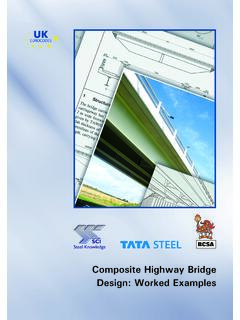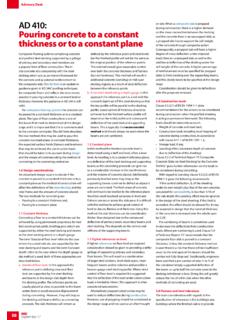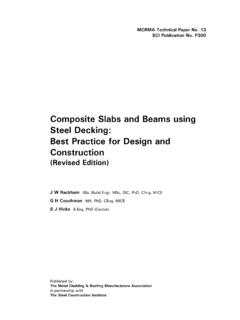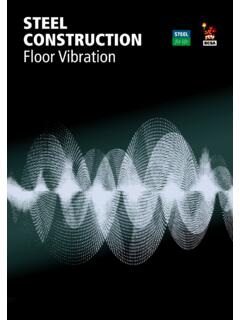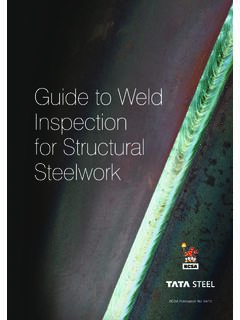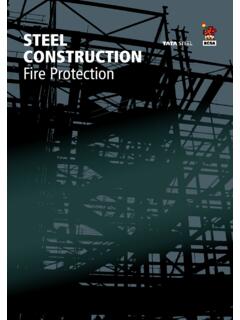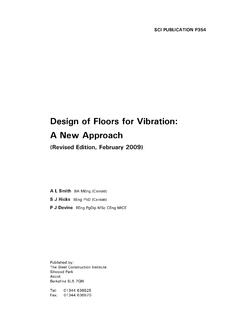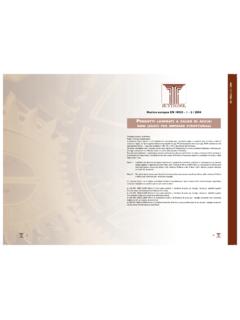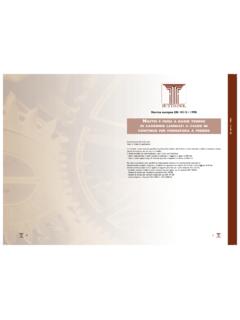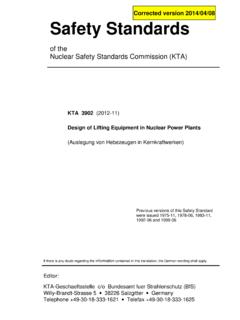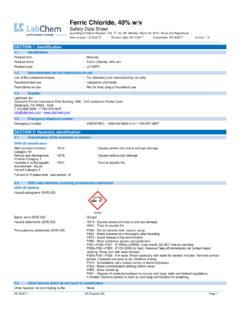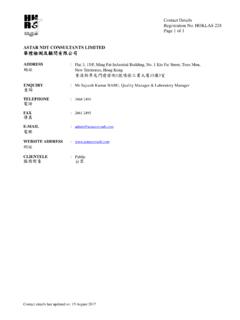Transcription of STEEL CONSTRUCTION CE Marking
1 STEELCONSTRUCTIONCE Marking2 CE MARKINGTata STEEL EuropeThe European operations of Tata STEEL comprise Europe s second largest STEEL producer. With the main steelmaking operations in the UK and Netherlands, they supply STEEL and related services to the CONSTRUCTION , automotive, packaging, lifting and excavating, energy and power, aerospace and other demanding markets worldwide. The combined Tata STEEL group is one of the world s largest STEEL producers, with an aggregate crude STEEL capacity of more than 28 million tonnes and approximately 80,000 employees across four Constructional Steelwork AssociationBCSA is the national organisation for the STEEL CONSTRUCTION industry: its Member companies undertake the design, fabrication and erection of steelwork for all forms of CONSTRUCTION in building and civil engineering. Industry Members are those principal companies involved in the direct supply to all or some Members of components, materials or products.
2 Corporate Members are clients, professional offices, educational establishments etc which support the development of national specifications, quality, fabrication and erection techniques, overall industry efficiency and good practice. Tata STEEL and the British Constructional Steelwork Association (BCSA) have worked closely together for many years to promote the effective use of structural steelwork. This collaborative effort ensures that advances in the knowledge of the constructional use of STEEL are shared with CONSTRUCTION is the most popular framing material for multi-storey buildings in the UK and has a long track record of delivering high quality and cost-effective structures with proven sustainability benefits. STEEL can be naturally recycled and re-used continuously, and offers a wide range of additional advantages such as health and safety benefits, speed of CONSTRUCTION , quality, efficiency, innovation, offsite manufacture and service and STEEL sector is renowned for keeping specifiers abreast of the latest advances in areas such as Building Information Modelling (BIM), fire protection of structural steelwork and achieving buildings with the highest sustainability ratings.
3 Recent publications have provided detailed guidance on Fire Protection, Cost, Thermal Mass and Embodied Carbon and what each means for the CONSTRUCTION sector. Guidance is provided on all relevant technical developments as quickly as is sector s go to resource website is a free online encyclopedia for UK CONSTRUCTION that shares a wealth of up-to-date, reliable information with the CONSTRUCTION industry in one easily accessible us on: @steelcoinfo Marking 3 Contents5 Introduction6 CE Marking of products7 CE Marking of fabricated structural steelwork9 Engineer s responsibility 1. Determine the Consequences Class 2. Selection of Execution Class13 Client and/or main contractor s responsibility14 How to check compliance with the CPR and CE Marking What to check - Factory Production Control and Welding Certificates What to check - Declaration of Performance16 SummaryThis guide has been updated to reflect the changes in determining Execution Class to the procedure outlined in earlier of interest: CE MARKING4 CE MARKINGCE Markingbecame mandatory CONSTRUCTION Products1 July 2013 Fabricated Structural Steelwork1 July 2014CE Marking 5CE Marking (formerly Conformit Europ enne) demonstrates compliance with the appropriate manufacturing standard for a product.
4 As a symbol, it will be familiar as it has been a requirement for many years on products sold in the European Union such as toys and electrical goods. Under the CONSTRUCTION Products Regulation (CPR), new legal obligations have been placed on manufacturers, distributors and importers of CONSTRUCTION products used within the EU to CE Mark their products where they are covered by either a harmonised standard or European Technical Assessment (ETA). This applies not only to constituent products (such as STEEL beams, bolts etc) but also to fabricated elements and systems made from both CE Marked and non-CE Marked products. In the UK, Trading Standards is the enforcement agency for non-compliance. Penalties for non-compliance include suspension notices, prohibition notices, notices to warn and application for forfeiture. For certain offences the penalties may include a fine, imprisonment or both.
5 The CPR required the CE Marking of all CONSTRUCTION products from 1 July 2013 and the CE Marking of fabricated structural steelwork from 1 July CPR describes the legal obligations it places on the CONSTRUCTION supply chain in terms of manufacturers , distributors and importers . However, the CONSTRUCTION supply chain in the UK would normally be described in terms of clients, designers, specifiers, contractors and specialist subcontractors. The purpose of this document is to provide some guidance to the UK supply chain on the implications of the CPR on STEEL requirements of the CPR and CE Marking apply to CONSTRUCTION products used on a project irrespective of whether that project has been designed to National Standards ( BS 5950) or to the CE MARKINGU nder the CPR, all products used in CONSTRUCTION must now have CE Marking to demonstrate compliance where either a harmonised standard or ETA is in force.
6 All mainstream CONSTRUCTION products are covered by harmonised standards and must therefore be CE Marked. For fabricated structural steelwork, engineers, contractors and steelwork contractors should have amended their specifications accordingly to ensure only CE Marked products are used on their projects. Manufacturers must publish declarations of performance for their products. Tata STEEL has published declarations of performance for its Advance section range and Celsius 355 and Hybox 355 structural hollow sections at Marking of productsProduct standards for CE Marking open sections BS EN 10025-1hollow sections hot finished BS EN 10210-1 cold formed welded BS EN 10219-1plates BS EN 10025-1fabricated structural steelwork BS EN 1090-1structural bolts non-preloaded structural bolting assemblies BS EN 15048-1 high strength structural bolting assemblies for preloading BS EN 14399-1 Note: A full list of harmonised standards can be found on the EU s Nando website hereSpecifications must ensure that only CE Marked products are used on projectsCE Marking 7 The harmonised standard covering fabricated structural steelwork is BS EN 1090: Execution of STEEL structures and aluminium structures.
7 Part 1 of the standard is the Requirements for Conformity Assessment of Structural Components. It describes how manufacturers can demonstrate that the components they produce meet the declared performance characteristics (the structural characteristics which make them fit for their particular use and function). Part 2 is the Technical Requirements for STEEL Structures. It specifies the requirements for the execution of STEEL structures to ensure adequate levels of mechanical resistance and stability, serviceability and durability. It determines the performance characteristics for components that the manufacturer must achieve and declare through the requirements of Part EN 1090-1 became mandatory on 1 July 2014. It is therefore now a legal requirement for all fabricated structural steelwork delivered to site to be CE Marked. The BCSA has made CE Marking compliance a condition of membership of the Association, so selection of any BCSA Member company guarantees that the steelwork contractor has the necessary certification to comply with the CPR requirements.
8 Clients and main contractors can therefore have confidence in the complete supply chain for STEEL CONSTRUCTION from manufacture of the STEEL sections through distribution to fabrication and erection on Marking of fabricated structural steelworkSpecificationsContracts for fabricated structural steelwork should include the following specification, which incorporates the obligations of BS EN 1090-1 and BS EN 1090-2 on the steelwork contractor:Buildings National Structural Steelwork Specification (NSSS) for Building CONSTRUCTION 5th Edition CE Marking VersionThe NSSS 5th Edition CE Marking Version should be incorporated into contract specifications for buildings8 CE MARKINGCE Marking 9 For any project, the required quality of fabrication or Execution Class (EXC) must be specified. The procedure to determine the Execution Class has recently been changed. It must now be determined according to the requirements of Annex C of BS EN 1993-1-1 and its associated National Annex.
9 The Execution Class must be specified for: the works as a whole an individual component a detail of a componentThe engineer is responsible for specifying the Execution Class for the structure (the works as a whole) and for components and details where it is appropriate to specify an Execution Class different to that specified for the structure. Where different, the Execution Class for a component or detail should not be lower than that specified for the works as a whole. The Execution Class for a component or detail should be clearly identified in the execution specification if it is different to the Execution Class for the structure. The procedure for determining the Execution Class for buildings is a straightforward two step process:1. Determine the Consequences Class2. Select the Execution ClassWhilst each building needs to be considered on its own merits, Execution Class 2 (EXC2) will be appropriate for the majority of buildings constructed in the UK.
10 If the Consequences Class is not specified, clause of the National Annex to BS EN 1993-1-1:2005+A1:2014 states that it should be assumed that the design rules in BS EN 1993 are safe for classes up to and including Consequences Class should also be noted that the NSSS for Building CONSTRUCTION 5th Edition CE Marking Version has been written for the steelwork contractor to deliver the requirements of EXC2. Engineer s responsibilityConsequences ClassTable 11 Approved Document AExecutionClassTable Annex toBS EN 1993-1-1:2005+A1:2014 Summary EXC2 will be the appropriate requirement for the majority of buildings constructed in the UK10 CE MARKINGN otes: 1. For buildings intended for more than one type of use the Consequence Class should be that pertaining to the most onerous In determining the number of storeys, basement storeys may be excluded provided such basement storeys fulfil the robustness requirements of Consequences Class 2b BS EN 1991-1-7:2006 with its UK National Annex also provides guidance that is comparable to Table purpose of categorising the Consequences Class (CC) is to ensure that buildings are constructed with the appropriate level of quality control within the fabrication process.
